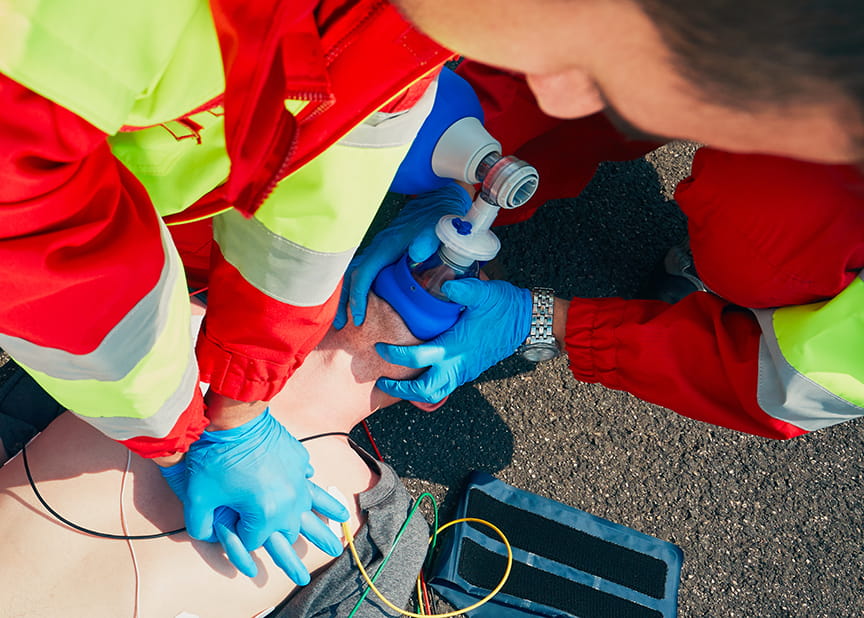There is considerable evidence that a variety of health care professionals do not consistently provide adequate bag valve mask (BVM) ventilation (BVMV).1 Ineffective BVMV may not only result in a failure to achieve cardiopulmonary stability, but also may complicate the patient’s condition.8 For example, hyperventilating a patient can cause gastric distension, which increases the risk of regurgitation, and increased intrathoracic pressure, which reduces cardiac output and consequently, perfusion of blood to the organs.7 Failure to achieve effective mask ventilation can be rescued by successful intubation, but difficult mask ventilation and difficult intubation often occur concurrently.6

The importance of proper mask ventilation cannot be overstated. Health care professionals should be confident in the skills to manage a basic airway until more advanced airway experts arrive. Even though most clinicians understand that effective mask ventilation and tracheal intubation are mutually inclusive rescue methods, optimizing the skill of mask ventilation is largely underappreciated.2 The primary focus should begin with mastery of mask ventilation before endotracheal tube insertion because it is not uncommon to encounter situations of both difficult ventilation and intubation that will ultimately call upon this much-needed skill.9
Airway management outcomes have improved through enhanced education, better airway algorithms, and innovations in airway management.9 The importance of optimizing the skill of mask ventilation should be emphasized, because effective mask ventilation can indeed minimize or reverse hypoxia, particularly if timely successful intubation is impossible.2
A BVM consists of three standard components: a self-inflating bag, a face mask, and a valve connecting these two components. Once the face mask is positioned properly on a patient, the provider then breathes for the patient by compressing the bag at a prescribed rate and with enough force to observe the patient’s chest rise.
One-Handed Mask Ventilation
The conventional teaching of mask ventilation uses one-handed mask (C-E) ventilation. If ineffective, then a two-handed technique is recommended, because two-handed approaches provide a better mask-to-face seal.4,3

Two-handed Mask Ventilation
There are two commonly used techniques of two-handed mask ventilation: the C-E technique and the V-E technique.2
The C-E technique applies the mask by forming a ‘C’ shape with each thumb and index finger over each side of the mask while the third, fourth, and fifth fingers of both hands lift the mandible toward the mask in a three fingered ‘E’ shape.2

The V-E technique uses the thumbs and the eminence of each hand placed over each side of the mask, while the second to fifth digits pull the jaw upward, again forming an ‘E’ shape.10 There are three components of the conventional V-E technique: (i) neck extension; (ii) lower jaw advance; and (iii) applying four fingers behind the angle of the mandible.10 Airway patency is improved with neck extension and lower jaw advancement.11

The benefits of the one-handed technique are that the provider has complete control of the airway and can adjust the mask as necessary to obtain a tight seal while allowing other rescuers to focus on other aspects of emergency care. Two-handed techniques require two people to provide the necessary oxygenation and ventilation, but they statistically provide better tidal volumes.5,1
No matter the technique used to properly mask ventilate a patient, the provider(s) need to be familiar with the BVM and how to use the device. They also need to be aware of when a technique isn’t working, and utilize those around them to institute the best airway intervention possible to obtain the best outcomes.
References
- Davidovic L, LaCovey D, Pitetti RD. Comparison of 1- versus 2-person bag valve-mask techniques for manikin ventilation of infants and children. Annals of Emergency Medicine. 2005;46(1):37-42.
- Fei M, Blair JL, Rice MJ, Edwards DA, Liang Y, Pilla MA, Shotwell MS, Jiang Y. (2017). Comparison of effectiveness of two commonly used two-handed mask ventilation techniques on unconscious apnoeic obese adults. British Journal of Anaesthesia. 2017;118(4):618-624.
- Gerstein NS, Carey MC, Braude DA, et al. Efficacy of facemask ventilation techniques in novice providers. Journal of Clinical Anesthesia. 2013;25:193-7.
- Hart D, Reardon R, Ward C, Miner J. Face mask ventilation: a comparison of three techniques. Journal of Emergency Medicine. 2013;44:1028-33.
- Joffe AM, Hetzel S, Liew EC. A two-handed jaw-thrust technique is superior to the one-handed “EC-clamp” technique for mask ventilation in the apneic unconscious person. Anesthesiology. 2010;113:873-9.
- Kheterpal S, Martin L, Shanks AM, Tremper KK. Prediction and outcomes of impossible mask ventilation: a review of 50,000 anesthetics. Anesthesiology. 2009;110:891-7.
- Kleinman ME, Chameides L, Schexnayder SM, Samson RA, Hazinski MF, Atkins DL, Zaritsky AL. Part 14: Pediatric advanced life support: 2010 American Heart Association guidelines for cardiopulmonary resuscitation and emergency cardiovascular care. Circulation. 2010;122:S876–S908.
- Mumma JL, Durso FT, Dyes M, dela Cruz R, Fox VP, Hoey M. Bag valve mask ventilation as a perceptual-cognitive skill. Human Factors. 2018;60(2):212-221.
- Rosen GP, Viswanath O, Wigley JC, Kerner B. Airway management: The less popular skill of bag-mask ventilation. Anesthesiology. 2018;129:1048-1051.
- Saddawi-Konefka D, Hung SL, Kacmarek RM, Jiang Y. Optimizing mask ventilation: literature review and development of a conceptual framework. Respiratory Care. 2015;60: 1834-40.
- Safar P, Escarraga LA, Chang F. Upper airway obstruction in the unconscious patient. Journal of Applied Physiology. 1959;14:760-4.
Recommended Articles

Managing Respiratory Arrest
Knowing and understanding the signs and symptoms of respiratory distress, failure, and arrest is crucial. Respiratory arrest is usually the endpoint of respiratory distress that leads to respiratory failure. Respiratory distress and failure have multiple causes, all of which, if left untreated, can deteriorate into respiratory arrest. The best treatment is knowing and understanding the signs and symptoms of respiratory distress and respiratory failure so interventions can be initiated and respiratory arrest averted altogether.




